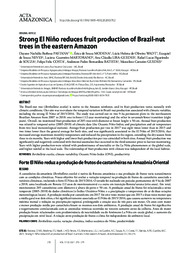Strong El Niño reduces fruit production of Brazil-nut trees in the eastern Amazon.
Strong El Niño reduces fruit production of Brazil-nut trees in the eastern Amazon.
Author(s): PASTANA, D. N. B.; MODENA, E. de S.; WADT, L. H. de O.; NEVES, E. de S.; MARTORANO, L. G.; LIRA-GUEDES, A. C.; SOUZA, R. L. F. de; COSTA, F. F.; BATISTA, A. P. B.; GUEDES, M. C.
Summary: The Brazil-nut tree (Bertholletia excelsa) is native to the Amazon rainforest, and its fruit production varies naturally with climatic conditions. Our aim was to evaluate the temporal variation in Brazil-nut production associated with climatic variables, including the strong El Niño of 2015/2016. The study was carried out in two 9-ha permanent plots in the northeastern Brazilian Amazon from 2007 to 2018: one in forest (12-year monitoring) and the other in savannah/forest transition (eight years). Overall, we monitored fruit production of 205 trees with diameter at breast height ? 50 cm. Annual fruit production was related to temporal series (2005-2018) of climatic data (the Oceanic Niño Index; and precipitation and air temperature from two local meteorological stations). Average fruit production per tree in 2017 was eight times lower than in 2015 and two times lower than the general average for both sites, and was significantly associated to the El Niño of 2015/2016, that increased average maximum monthly temperature and reduced the precipitation in the region, extending the dry season from three to six months. Years with higher and lower fruit production per tree coincided in both sites. Annual fruit production was significantly and negatively correlated with thermal anomalies that occurred in the third semester prior to harvest monitoring. Years with higher production were related with predominance of neutrality or the La Niña phenomenon at the global scale, and higher rainfall at the local scale. The relationship of fruit production with climate was independent of the local habitat.
Publication year: 2021
Types of publication: Journal article
Unit: Embrapa Amapá
Observation
Some of Embrapa's publications are published as ePub files. To read them, use or download one of the following free software options to your computer or mobile device. Android: Google Play Books; IOS: iBooks; Windows and Linux: Calibre.
Access other publications
Access the Agricultural Research Database (BDPA) to consult Embrapa's full library collection and records.
Visit Embrapa Bookstore to purchase books and other publications sold by Embrapa.

